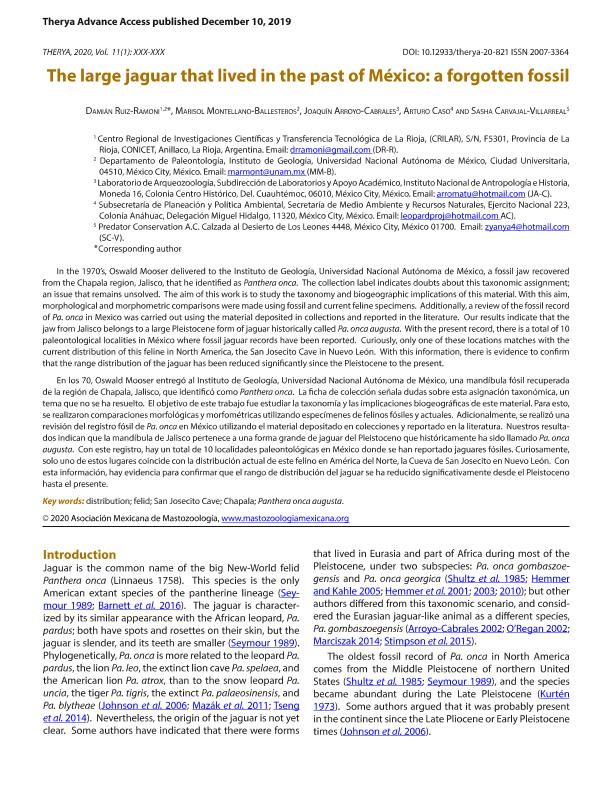Mostrar el registro sencillo del ítem
dc.contributor.author
Ruiz Ramoni, Damián

dc.contributor.author
Montellano Ballesteros, Marisol
dc.contributor.author
Arroyo Cabrales, Joaquín

dc.contributor.author
Caso, Arturo
dc.contributor.author
Carvajal Villarreal, Sasha
dc.date.available
2021-10-15T01:42:30Z
dc.date.issued
2019-12
dc.identifier.citation
Ruiz Ramoni, Damián; Montellano Ballesteros, Marisol; Arroyo Cabrales, Joaquín; Caso, Arturo; Carvajal Villarreal, Sasha; The large jaguar that lived in the past of México: A forgotten fossil; Asociacion Mexicana de Mastozoologia; Therya; 11; 1; 12-2019; 1-10
dc.identifier.issn
2007-3364
dc.identifier.uri
http://hdl.handle.net/11336/143724
dc.description.abstract
In the 1970’s, Oswald Mooser delivered to the Instituto de Geología, Universidad Nacional Autónoma de México, a fossil jaw recovered from the Chapala region, Jalisco, that he identified as Panthera onca. The collection label indicates doubts about this taxonomic assignment; an issue that remains unsolved. The aim of this work is to study the taxonomy and biogeographic implications of this material. With this aim, morphological and morphometric comparisons were made using fossil and current feline specimens. Additionally, a review of the fossil record of Pa. onca in Mexico was carried out using the material deposited in collections and reported in the literature. Our results indicate that the jaw from Jalisco belongs to a large Pleistocene form of jaguar historically called Pa. onca augusta. With the present record, there is a total of 10 paleontological localities in México where fossil jaguar records have been reported. Curiously, only one of these locations matches with the current distribution of this feline in North America, the San Josecito Cave in Nuevo León. With this information, there is evidence to confirm that the range distribution of the jaguar has been reduced significantly since the Pleistocene to the present.
dc.description.abstract
En los 70, Oswald Mooser entregó al Instituto de Geología, Universidad Nacional Autónoma de México, una mandíbula fósil recuperada de la región de Chapala, Jalisco, que identificó como Panthera onca. La ficha de colección señala dudas sobre esta asignación taxonómica, un tema que no se ha resuelto. El objetivo de este trabajo fue estudiar la taxonomía y las implicaciones biogeográficas de este material. Para esto, se realizaron comparaciones morfológicas y morfométricas utilizando especímenes de felinos fósiles y actuales. Adicionalmente, se realizó una revisión del registro fósil de Pa. onca en México utilizando el material depositado en colecciones y reportado en la literatura. Nuestros resultados indican que la mandíbula de Jalisco pertenece a una forma grande de jaguar del Pleistoceno que históricamente ha sido llamado Pa. onca augusta. Con este registro, hay un total de 10 localidades paleontológicas en México donde se han reportado jaguares fósiles. Curiosamente, solo uno de estos lugares coincide con la distribución actual de este felino en América del Norte, la Cueva de San Josecito en Nuevo León. Con esta información, hay evidencia para confirmar que el rango de distribución del jaguar se ha reducido significativamente desde el Pleistoceno hasta el presente.
dc.format
application/pdf
dc.language.iso
eng
dc.publisher
Asociacion Mexicana de Mastozoologia
dc.rights
info:eu-repo/semantics/openAccess
dc.rights.uri
https://creativecommons.org/licenses/by-nc-sa/2.5/ar/
dc.subject
CHAPALA
dc.subject
DISTRIBUTION
dc.subject
FELID
dc.subject
PANTHERA ONCA AUGUSTA
dc.subject
SAN JOSECITO CAVE
dc.subject.classification
Paleontología

dc.subject.classification
Ciencias de la Tierra y relacionadas con el Medio Ambiente

dc.subject.classification
CIENCIAS NATURALES Y EXACTAS

dc.title
The large jaguar that lived in the past of México: A forgotten fossil
dc.type
info:eu-repo/semantics/article
dc.type
info:ar-repo/semantics/artículo
dc.type
info:eu-repo/semantics/publishedVersion
dc.date.updated
2021-09-07T20:07:10Z
dc.journal.volume
11
dc.journal.number
1
dc.journal.pagination
1-10
dc.journal.pais
México

dc.journal.ciudad
Ciudad de México
dc.description.fil
Fil: Ruiz Ramoni, Damián. Consejo Nacional de Investigaciones Científicas y Técnicas. Centro Regional de Investigaciones Científicas y Transferencia Tecnológica de La Rioja. - Universidad Nacional de La Rioja. Centro Regional de Investigaciones Científicas y Transferencia Tecnológica de La Rioja. - Universidad Nacional de Catamarca. Centro Regional de Investigaciones Científicas y Transferencia Tecnológica de La Rioja. - Secretaría de Industria y Minería. Servicio Geológico Minero Argentino. Centro Regional de Investigaciones Científicas y Transferencia Tecnológica de La Rioja. - Provincia de La Rioja. Centro Regional de Investigaciones Científicas y Transferencia Tecnológica de La Rioja; Argentina. Universidad Nacional Autónoma de México; México
dc.description.fil
Fil: Montellano Ballesteros, Marisol. Universidad Nacional Autónoma de México; México
dc.description.fil
Fil: Arroyo Cabrales, Joaquín. Instituto Nacional de Antropología E Historia; México
dc.description.fil
Fil: Caso, Arturo. Subsecretaría de Planeación y Política Ambiental, Secretaría de Medio Ambiente y Recursos Naturales; México
dc.description.fil
Fil: Carvajal Villarreal, Sasha. No especifíca;
dc.journal.title
Therya
dc.relation.alternativeid
info:eu-repo/semantics/altIdentifier/doi/http://dx.doi.org/10.12933/therya-20-821
dc.relation.alternativeid
info:eu-repo/semantics/altIdentifier/url/http://132.248.10.25/therya/index.php/THERYA/article/view/821
Archivos asociados
